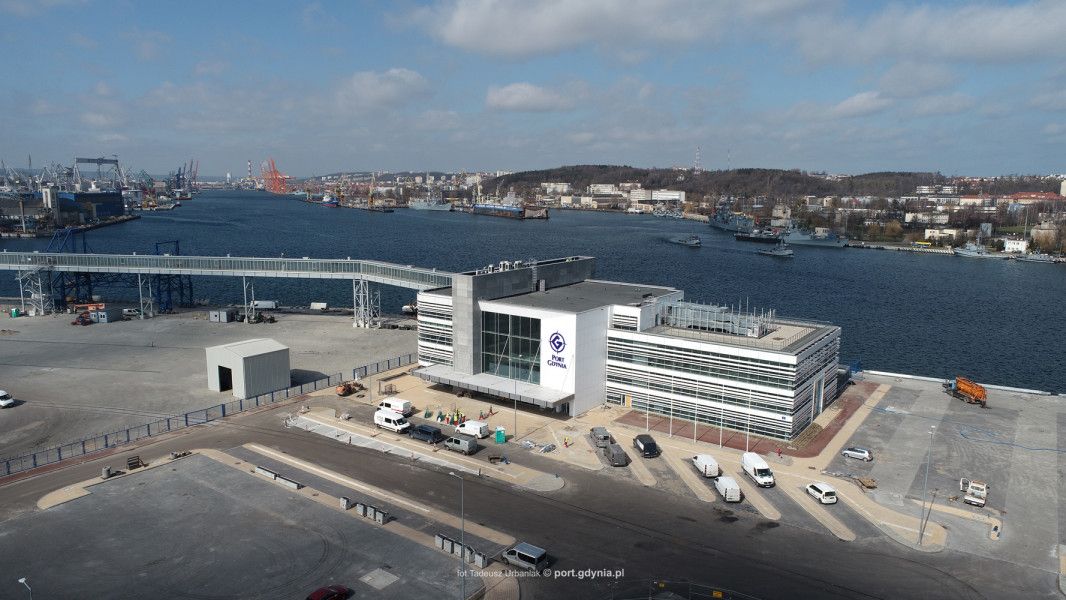PUBLIC FERRY TERMINAL IN THE #Greenport Concept
Published: 09 April 2021
In June the new Public Ferry Terminal, an investment of the Port of Gdynia Authority S.A. will be completed.
This is the largest project in nearly 50 years at the Port of Gdynia, whose general contractor is Korporacja Budowlana DORACO Sp. z o.o. The investment is being carried out on an area of 6 hectares. The historic Polskie Quay was demolished and the entire quay line was newly constructed.
Thanks to this huge investment, which translates into sustainable development of the port, transport accessibility from the sea will be increased, making the port more competitive.
Not only ferries such as Stena Line, but also other ferry operators will be able to use the investment. The Port of Gdynia will be able to accept vessels with a length of up to 240 m, i.e. the target size of serviced ferries related to the conditions of the Baltic market.
Both the Port of Gdynia and the city of Gdynia will benefit from the soon to be opened terminal. More passengers and tourists means, above all, the development of local industries. It will also create new jobs, increase the number of new services related to sea and land transport.
An important aspect of the new Public Ferry Terminal will be the possibility of powering the ferries during their stop. This is in line with the idea of the so-called “green port”. This solution completely eliminates the emission of exhaust fumes during the stay of ferries at the quay. This is of great importance for the Port of Gdynia, which is located in the vicinity of the city centre and thus air pollution would affect many inhabitants of Gdynia and the city centre would lose its attractiveness.
OPS, i.e. onshore power supply, also called cold ironing, is a system supplying power onto a ship from land during its stay at the port.
Powering ships with electricity while in port has a very beneficial effect on the environment by reducing noise levels in port, almost completely reducing noise and vibration on the ship by shutting down the engines and extending the life of auxiliary engines on the ship.
Research has shown that 10 hours of power use in port by a large cruise ship reduces CO₂ emissions by 22 tons, nitrogen oxides by 1.4 tons and sulphur oxides by 1.2 tons.
The shore power supply system for the ships is based on a dedicated converter station in the form of a built-in container, a cable line laid along the Polskie Quay in the cable duct, cable outlets located in three places on the quay and a mobile crane (a device that will move along the quay and feed the cable with a “socket” to the ship).
“The system of this type is used Karlskrona, Goteborg and Stockholm (as of December 2020). Historically, the first port to install a shore power system was the US Port of Los Angeles in June 2004, and the first ship to use it was the Japanese container ship NYK Atlas,” adds Capt. Mieczysław Amielańczyk, who sailed as a senior officer on passenger ships such as Albatros, Minerwa and Explorer, and earlier as the second officer on the Stefan Batory. He also served as Captain on the casino ship “The Mercury”, sailing in the Singapore and Malacca Straits.
However, this is the first system of this type in Poland, so it is undoubtedly innovative and avant-garde in this respect: this investment will certainly determine the way of implementing this type of installation in Polish ports. It raises the standard of the ship service and allows to connect ships mooring to the quay based on modern infrastructure.
“A prosperous business combined with care for the environment is nowadays a standard that attracts new customers. While implementing strategic investments, we cannot forget about the surrounding environment. The construction of the Public Terminal in Gdynia is a large-scale project that we are implementing as part of sustainable development,” comments Adam Meller, President of the Board of the Port of Gdynia S.A.
The power of our connection for ships is 3.5 MW, which means the ability to quickly “charge” the batteries of a given ferry, without having to turn on the diesel engines, which are certainly not environmentally friendly and for this reason reducing their role becomes the goal of many pro-ecological activities in many areas of the economy. The system is designed to power ships with an on-board 11kV 50Hz/60Hz installation from the shore power grid of 15kV 50Hz.
It is also worth noting the emergence on the transport market of vessels powered only by electric engines, which can be supplied from such a connection. Thanks to the system described above, the Port of Gdynia will be able to service such vessels as early as in September.
“An interesting fact is that the container device, i.e. the connection station (converter), was located just below the flyover, as a result of our search for optimal solutions in the organization of site development -” says Karol Zduńczyk, President of the Board of DORACO Building Corporation, the general contractor of the investment. “The size of this container and the height of the space under the flyover gave us only about 50 cm of clearance, which precluded the insertion of a container weighing nearly 30 tons with the help of a crane. The station was therefore ‘slid in’ using sliding rails and actuators to position the unit in its intended location.”
The Port of Gdynia is a base node of the trans-European TEN-T network and a category A port and one of the two Polish seaports connected with Sweden via the Gdynia-Karlskrona Motorway. The position of the Port of Gdynia is, among other things, related to its role in the Baltic Adriatic Corridor, which is one of the 9 key transport corridors of the TEN-T network.
The location of the Public Ferry Terminal at the Polskie Quay will provide a connection to the most important local and national roads, which are an important element of the transport corridor of international trade. The first ship call at the new terminal is scheduled for September of this year. The value of the investment is approximately 292 million PLN, of which the European Union co-financing is 116,837,137.67 PLN.


ul. Rotterdamska 9, 81-337 Gdynia
Regon: 191920577 NIP: 9581323524 KRS: 0000082699


